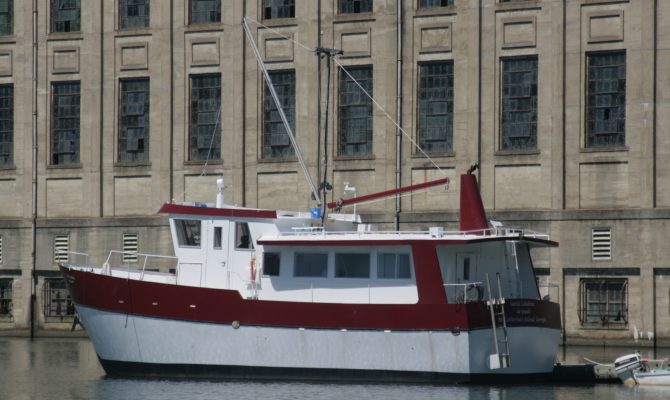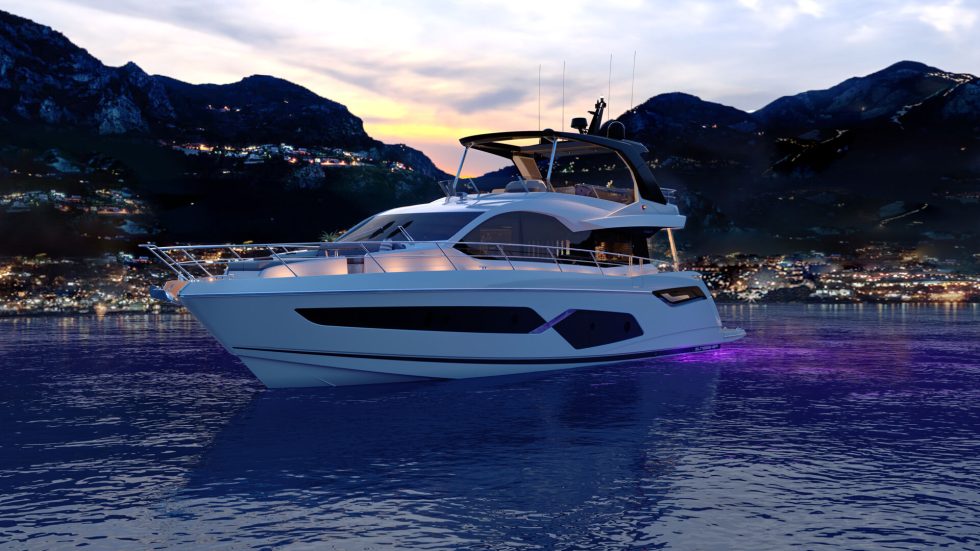Tim Keith-Lucas, PhD, has been many things in his life. The fourth-generation academic is Professor of Psychology, Emeritus, at Sewanee: The University of the South. He manages the Primate Research Program on St. Catherine’s Island, Ga., where 80-some lemurs run free. He is an airplane pilot, a Sheriff’s Deputy, and was a volunteer EMT and fireman.
He has logged sea time sailing in various waters, including along the Brittany coast.
But he had never built a boat and never learned to weld. That all changed in the fall of 2000 when he took delivery of 250 pieces of laser-cut steel. After deciding to build his own boat, he bought a plan on the Internet from a naval architect, and that was the start of a 12-year saga.
He first considered a 40-foot sloop that he knew could handle serious weather but felt the demands of sailing one might be too great. His second choice was a trawler, but the most seaworthy ones were out of his price range, and the others didn’t quite meet his requirements.
So, he built his own. It is 44 feet long, 15 feet wide, weighs 23 tons and has a single 140-hp diesel. The hull is 6-milimeters thick, which is almost 1/4 inch, and the superstructure is 4-milimeters thick. Drawing 5 feet, it carries 1,000 gallons of fuel, 140 gallons of fresh water, and has a 55 gallon black tank and slightly smaller gray tank.
The main level has a helm, galley, head/shower and combination dining/salon/guest bedroom area. The master suite is forward below, with a head and shower just aft. The top deck holds a boom and crane, along with a variety of safety equipment and “toys.”
Named after a mission on St. Catherine’s Island, the Santa Catalina de Guale was moved to Hales Bar Marina on the Tennessee River this spring from his “workshop” that had a roof but no sides. He plans to continue work on it this summer, then head to Carrabelle, Fla., in the fall.
The first year he worked on the boat, he made very little progress, as he tried to figure out how to single-highhandedly pick up and position the steel sheets, some of which were 20 feet long and 8 feet wide. Tolerance had to be within 1 millimeter, and forming the sheets into curves was even more difficult. Pry bars, chains and come-alongs were’t working.
Fortunately, a friend, “Otto” Bailey, had run a military surplus equipment business and offered Keith-Lucas a Krane Kar, a mobile hydraulic crane used to remove aircraft engines. Its overall condition was a “disaster,” but the parts of it he needed to work for him did so perfectly. It also allowed him to suspend his welder close to the work to make tacking the sheets together easier.
Outside of some help from his son during those heavy metal years, he mainly worked alone. The bottom was laid up longitudinally, then frames and stringers were added until at one point, Keith-Lucas says it looked like a “birdcage with a floor.”
As he progressed, he began to use material from unlikely sources. Part of the 2,000 pounds of lead ballast was spent and pancaked bullet lead that was put in 15 pound bags, placed in the hull and held in place with tar. Another 1,100 pounds was part of a floor from a NASA test building.
Basically, Keith-Lucas says, the boat is “built out of junk.” He used as much salvage as possible when it was appropriate and didn’t compromise the boat’s integrity or safety.
“I did not set out to build a yacht,” he says. “It is a miniature ship. I also needed to be able to afford to maintain it.” That led to the use of commercial-grade coatings and fittings that leave less than a Bristol finish but are durable and provide low maintenance protection.
Much of the salvage came from Marvin Steele’s salvage yard in Winchester, Tenn. “He had so much stuff I mapped it just to make it easier to locate what I was looking for,” notes Keith-Lucas.
Marvin also “had an amazing ability to guess how much money I had in my pocket” every time they settled up.
Some examples include battery cables made from 40-foot lengths of heavy duty, four conductor cable; passenger car seats for the pilot and passenger from an unknown vehicle; and a windshield wiper that came from “God only knows where.”
The 453 Detroit Diesel engine was a mothballed Navy motor; the 6.5-kW generator came from a Florida marine salvage yard; the front bell was on a World War II light harbor tug and was donated by friends; the two anchor winches are from a military fire engine; and the back-up high torque winch pulled rope and chain on an antique boat.
The fuel tanks are used agricultural equipment; a part of the lifting crane on the top deck is a used sailboat mast; and the funnel for the dry exhaust pipes was originally a stainless-steel tube that was cut and reshaped.
The other departure from normal boat construction is Keith-Lucas’ intense focus on safety and seaworthiness. “When I became a pilot, I studied the reasons for aircraft accidents.” Likewise, knowing the two worst things that can happen on a boat are fire and sinking, “I decided to do whatever I could to prevent either one from happening.”
Part of his credo involves thinking “I am not planning on getting into a hurricane, but….” His approach to safety, navigation and other things is to always have a Plan B.
 |
|
|
|
|
There is only one through-hull that connects to a water distribution manifold. The lever on that seacock is wired to a knob in the galley floor that can be pulled to shut the valve. The dry exhaust system eliminates holes at the water line.
A knob at the helm shuts the engine down by closing the damper to the engine’s supercharger. Another switch disconnects the batteries.
He has a SPOT Satellite GPS Messenger unit that sends the position of the boat to him daily. Three sensors monitor the main bilge pump’s running time, a smoke alarm and fusible links in the engine room.
The heavy-weather windows are fixed-glazed, 1/2-inch Lexan, which is almost bullet-proof. The doors have a 4-millimeter steel skin, steel reinforcements and, besides the normal latch, have two sea latches he fabricated from 1-inch pipe. Likewise, all the cabinetry has extra latching devices.
Besides the standard bilge pumps, he keeps a gas-powered, 150-gallon-per-minute(gpm) pump on the bow that can be quickly connected to built-in pipes that run from the bottom of a galley cabinet to the lowest point in the engine room. Other bilge areas can be accessed by dropping hoses down hatches. The pump can also supply water for fire-fighting hoses or remove sewage.
To prevent sinking from a break in his own water lines, he used reinforced fuel hoses.
The life ring has an attached high-visibility marker pole, and the crane is rigged to lift a person out of the water.
He even engineered and installed an emergency hand-operated rudder tiller. A removable plate just aft of the cabin exposes the top of the rudder post, so an extension can be attached to provide manual control.
On the upper deck, he keeps an emergency offshore life raft along with bicycles, kayaks, a 12-foot aluminum dinghy and a Laser sailboat.
It has been a long, tiring, sometimes frightful journey, and at times, both emotionally and physically painful. The frustration and overwhelming challenge brought him to tears many times. It also took him twice to the optometrist to have debris removed from his eyes and twice to the emergency room.
Several things kept him going. There was a feeling that once he had publicly committed to the project he had to finish. Another was that he realized his financial outlay would be lost if the boat wasn’t done. He also cites the days when his wife, who is the boat’s weather expert, would go with him to the work site and offer support and encouragement as a much welcomed source of comfort.
At his lowest point, when the challenge seemed too great, he thoughtfully analyzed the situation and realized the idea of building a boat was too great a challenge. Instead, he tried focusing on just finishing one task at a time, and that proved manageable. Given the number of tasks he has completed and still has stretching before him, his diagnosis and prescription was perfect.
It was a classic case of doctor, heal thyself.




